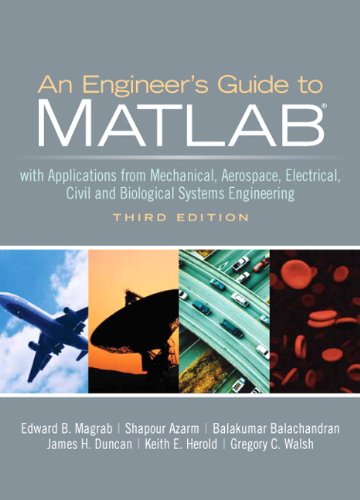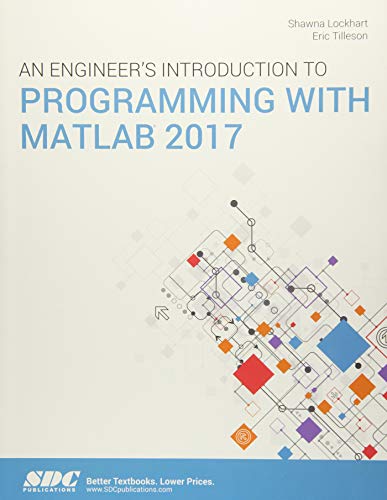We spent many hours on research to finding engineers guide to matlab, reading product features, product specifications for this guide. For those of you who wish to the best engineers guide to matlab, you should not miss this article. engineers guide to matlab coming in a variety of types but also different price range. The following is the top 9 engineers guide to matlab by our suggestions:
Reviews
1. An Engineers Guide to MATLAB (3rd Edition)
Description
An Engineer's Guide to MATLAB, 3/e, is an authoritative guide to generating readable, compact, and verifiably correct MATLAB programs. It is ideal for undergraduate engineering courses in Mechanical, Aeronautical, Civil, and Electrical engineering that require/use MATLAB.
This highly respected guide helps students develop a strong working knowledge of MATLAB that can be used to solve a wide range of engineering problems. Since solving these problems usually involves writing relatively short, one-time-use programs, the authors demonstrate how to effectively develop programs that are compact yet readable, easy to debug, and quick to execute. Emphasis is on using MATLAB to obtain solutions to several classes of engineering problems, so technical material is presented in summary form only.
The new edition has been thoroughly revised and tested for software release 2009.
2. An Engineer's Introduction to Programming with MATLAB 2018
Description
This book accomplishes two things simultaneously: it teaches you to use the latest version of the powerful MATLAB programming environment, and it teaches you core, transferrable programming skills that will make you feel at home with most procedural programming languages.
MATLAB has been in existence for more than 30 years and is used by millions of engineers, scientists, and students worldwide, both for its depth and its easy usability. With dozens of specialized toolboxes available beyond the core program, as well as its companion program Simulink for simulation and model-based design, MATLAB can serve as an invaluable aid throughout your career.
Unlike many MATLAB books, ours assumes no prior experience in computer programming. Using an approachable tone, we take you from the simplest variables through complex examples of data visualization and curve fitting. Each chapter builds on the last, presenting an in-depth tutorial on a focused concept central to programming, using the MATLAB language, but applicable to countless other popular and in-demand languages such as C++, Java, JavaScript, R, and Python. We'll ask you to perform short exercises as we work through each chapter, followed by more end-to-end exercises and mental challenges at the chapter's end. As the complexity of the concepts increases, the exercises present increasingly real-world engineering challenges to match.
Once you've completed An Engineer's Introduction to Programming with MATLAB 2018, you will have a solid foundation in computer programming forms and concepts and a comfort with the MATLAB environment and programming language. We believe that you'll enjoy both gaining and having that knowledge, and that you'll be able to use it almost immediately with your other coursework.
Table of Contents
1. Introduction to MATLAB2. Programming Basics: Operators & Variables
3. Programming Basics: Arrays and Structures
4. Programming Basics: Looping and Conditionals
5. Matrices
6. Functions and Scripts
7. Debugging and Error Handling
8. Importing and Exporting Data
9. Plotting and Data Visualization
10. MATLAB ToolBoxes: Curve Fitting
11. Symbolic Math
Index
3. An Engineer's Introduction to Programming with MATLAB 2017
Description
This book accomplishes two things simultaneously: it teaches you to use the latest version of the powerful MATLAB programming environment, and it teaches you core, transferrable programming skills that will make you feel at home with most procedural programming languages.
MATLAB has been in existence for more than 30 years and is used by millions of engineers, scientists, and students worldwide, both for its depth and its easy usability. With dozens of specialized toolboxes available beyond the core program, as well as its companion program Simulink for simulation and model-based design, MATLAB can serve as an invaluable aid throughout your career.
Unlike many MATLAB books, ours assumes no prior experience in computer programming. Using an approachable tone, we take you from the simplest variables through complex examples of data visualization and curve fitting. Each chapter builds on the last, presenting an in-depth tutorial on a focused concept central to programming, using the MATLAB language, but applicable to countless other popular and in-demand languages such as C++, Java, JavaScript, R, and Python. We'll ask you to perform short exercises as we work through each chapter, followed by more end-to-end exercises and mental challenges at the chapter's end. As the complexity of the concepts increases, the exercises present increasingly real-world engineering challenges to match.
Once you've completed An Engineer's Introduction to Programming with MATLAB 2017, you will have a solid foundation in computer programming forms and concepts and a comfort with the MATLAB environment and programming language. We believe that you'll enjoy both gaining and having that knowledge, and that you'll be able to use it almost immediately with your other coursework.
Table of Contents
1. Introduction to MATLAB2. Programming Basics: Operators & Variables
3. Programming Basics: Arrays and Structures
4. Programming Basics: Looping and Conditionals
5. Matrices
6. Functions and Scripts
7. Debugging and Error Handling
8. Importing and Exporting Data
9. Plotting and Data Visualization
10. MATLAB ToolBoxes: Curve Fitting
11. Symbolic Math
Index
4. Mastering Mechanics I, Using MATLAB: A Guide to Statics and Strength of Materials
Description
This guide to the most common statics and strength of materials problems shows by example how to create function files to solve generic problems. Problems include rigid body equilibrium, geometry, shear stresses and strains, Mohr's circle, numerous types of loading, and beams. The book can be used as a review or supplemental text and requires only a passing familiarity with MATLAB. Annotation c. by Book News, Inc., Portland, Or.5. Practical Control Engineering: Guide for Engineers, Managers, and Practitioners (MATLAB Examples)
Description
Publisher's Note: Products purchased from Third Party sellers are not guaranteed by the publisher for quality, authenticity, or access to any online entitlements included with the product.
An Essential Guide to Control Engineering Fundamentals
Understand the day-to-day procedures of today's control engineer with the pragmatic insights and techniques contained in this unique resource. Written in clear, concise language, Practical Control Engineering shows, step-by-step, how engineers simulate real-world phenomena using dynamic models and algorithms. Learn how to handle single and multiple-staged systems, implement error-free feedback control, eliminate anomalies, and work in the frequency and discrete-time domains. Extensive appendices cover basic calculus, differential equations, vector math, Laplace and Z-transforms, and Matlab basics. Practical Control Engineering explains how to:
- Gain insight into control engineering and process analysis
- Write and debug algorithms that simulate physical processes
- Understand feedback, feedforward, open loops, and cascade controls
- Build behavioral models using basic applied mathematics
- Analyze lumped, underdamped, and distributed processes
- Comprehend matrix, vector, and state estimation concepts
- Convert from continuous to discrete-time and frequency domains
- Filter out white noise, colored noise, and stochaic disturbances
6. An Introduction to MATLAB Programming and Numerical Methods for Engineers
Feature
MATLAB TextbookInstructions on programming MATLAB
Description
Assuming no prior background in linear algebra or real analysis, An Introduction to MATLAB Programming and Numerical Methods for Engineers enables you to develop good computational problem solving techniques through the use of numerical methods and the MATLAB programming environment. Part One introduces fundamental programming concepts, using simple examples to put new concepts quickly into practice. Part Two covers the fundamentals of algorithms and numerical analysis at a level allowing you to quickly apply results in practical settings.- Tips, warnings, and "try this" features within each chapter help the reader develop good programming practices
- Chapter summaries, key terms, and functions and operators lists at the end of each chapter allow for quick access to important information
- At least three different types of end of chapter exercises thinking, writing, and coding let you assess your understanding and practice what you've learned
7. Modeling and Simulation in Medicine and the Life Sciences (Texts in Applied Mathematics)
Feature
Used Book in Good ConditionDescription
The result of lectures given by the authors at New York University, the University of Utah, and Michigan State University, the material is written for students who have had only one term of calculus, but it contains material that can be used in modeling courses in applied mathematics at all levels through early graduate courses. Numerous exercises are given as well as solutions to selected exercises, so as to lead readers to discover interesting extensions of that material. Throughout, illustrations depict physiological processes, population biology phenomena, corresponding models, and the results of computer simulations. Topics covered range from population phenomena to demographics, genetics, epidemics and dispersal; in physiological processes, including the circulation, gas exchange in the lungs, control of cell volume, the renal counter-current multiplier mechanism, and muscle mechanics; to mechanisms of neural control. Each chapter is graded in difficulty, so a reading of the first parts of each provides an elementary introduction to the processes and their models.8. A Guide to MATLAB: For Beginners and Experienced Users
Feature
NewSecond Edition
Description
This is a short, focused introduction to MATLAB, a comprehensive software system for mathematical and technical computing. It contains concise explanations of essential MATLAB commands, as well easily understood instructions for using MATLAB's programming features, graphical capabilities, simulation models, and rich desktop interface. Written for MATLAB 7 it can also be used with earlier (and later) versions of MATLAB.This book teaches how to graph functions, solve equations, manipulate images, and much more. It contains explicit instructions for using MATLAB's companion software, Simulink, which allows graphical models to be built for dynamical systems. MATLAB's new "publish" feature is discussed, which allows mathematical computations to be combined with text and graphics, to produce polished, integrated, interactive documents.9. Fluid-Structure Interaction: An Introduction to Finite Element Coupling
Description
Fluid-Structure Interaction: An Introduction to Finite Element Coupling fulfils the need for an introductive approach to the general concepts of Finite and Boundary Element Methods for FSI, from the mathematical formulation to the physical interpretation of numerical simulations. Based on the authors experience in developing numerical codes for industrial applications in shipbuilding and in teaching FSI to both practicing engineers and within academia, it provides a comprehensive and selfcontained guide that is geared toward both students and practitioners of mechanical engineering. Composed of six chapters,
FluidStructure Interaction: An Introduction to Finite Element Coupling progresses logically from formulations and applications involving structure and fluid dynamics, fluid and structure interactions and opens to reduced order-modelling for vibro-acoustic coupling. The author describes simple yet fundamental illustrative examples in detail, using analytical and/or semianalytical formulation & designed both to illustrate each numerical method and also to highlight a physical aspect of FSI. All proposed examples are simple enough to be computed by the reader using standard computational tools such as MATLAB, making the book a unique tool for selflearning and understanding the basics of the techniques for FSI, or can serve as verification and validation test cases of industrial FEM/BEM codes rendering the book valuable for code verification and validation purposes.









